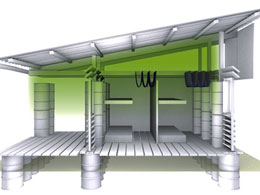COLUMNS
LEVELLING
In 2007, UIA Work Programme on 'Architecture and Renewable Energy Sources' [UIA-ARES WP] in cooperation with Technical Chamber of Greece launched an international architectural competition on "Sustainable Architecture and Renewable Energy shells for housing victims of major natural disasters". There were 67 submissions, from which the committee chose no. 508 as the best (see images below -click to enlarge).
The first prize of ARES-UIA 2007 competition, implemented in Morocco.
The Portuguese designers explain that they chose "the cube, the tent, and the accordion as a thematic, morphological, and practical reference, respectively".
The folding cube includes costly P/V panels, which boost its aerodynamic properties and provide the high voltage power required by the electric hotplates on a fibreglass "wet box" (shown yellow on the plan). The latter includes a conventional sink, with a flush toilet next to the sleeping area, assuming adequate water supplies and sewage.
With such unprecedented amenities like in a Western caravan, most refugees would rather be grateful for the calamity. The photo on the right illustrates the realities that an emergency settlement should deal with.
As suggested by the committee, "This entry proposes the maximum use of renewable energy sources. The prefabricated folding units offer a generic solution to critical situations at different climatic zones." The drawings of the proposal explain that climate adaptation is achieved by changing the RAL colour of the fabric: "orange & sand colors in desert & savannah zones, blue in north zones, green in the tropical zones, for a better relation with the surrounding environment."
Most of the proposed schemes focused on the requested object, the shelters. But the shelters -even with extensive use of renewable energy- are not sufficient to create conditions for the survival and coexistence of refugees. Under critical conditions, priorities differ from those of normal everyday life and also from the conventional assumptions of architectural design. For example, drinking water is more vital than electricity for the TV, the usual notion of 'comfort' is different, and the collective spirit is a precondition of survival. At the same time, the conversion from productive people into idle refugees triggers a psychological burden with adverse effects on the community. It is clear that renewable energy sources, especially in single-unit scale, are not sufficient to address the many challenges of a refugee settlement.
This article points to a proposal that put emphasis not so much on the single shelter but on the overall living situation of the refugees, employing a more holistic approach. The objective was not to design an IKEA-like house kit that would be shipped en masse over thousands of kilometres, but a housing organism adapted to local conditions, minimizing the need for outside assistance, and encouraging the mobilization of the victims. Practical realism was an important design yardstick in assessing problems and in the ways to resolve them. The house units were adapted to local family customs and were considered as pieces of a larger mechanism, with general proposals on the essential infrastructure and on ways to orchestrate the entire settlement in space and time.
The Design Description of the proposal follows below; a pdf copy can be found here.
[See related blog for comments]
ARES-UIA International Architecture Competition 2007
Entry 564: The Oil Barrel Project - Design Description
Design team: Thanos N. Stasinopoulos & Phaethon Psichis, with Orestis Borbantonakis & Juliette Sohier.
Summary
This proposal addresses an environmental disaster caused by wide scale contamination due to human negligence. It focuses on the Niger Delta region where a growing accumulation of soil-, water- and air-pollution has already affected the lives of several thousand people, pressing them to flee from the advancing catastrophe.
A key feature of the design is a structural system based on the abundant oil barrels of the area. It is used to compile an organic network where each group includes others -or is included by another- of a similar circular structure.
The environmental issues of the entire project, from dwellings to camp, have been considered through the Four Elements prism, i.e. the varied aspects of energy, water, air, and matter.
The proposal is based on the participation of the locals in self-help schemes, from dwelling construction to camp operation, as an elemental method not only for reducing costs but mainly for mobilizing the distressed refugees and enabling them to regain their everyday lives and dignity.
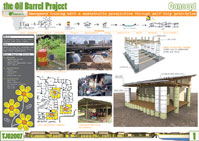
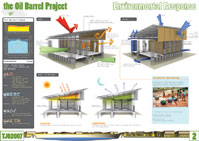
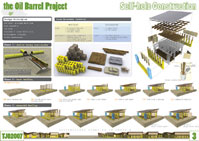
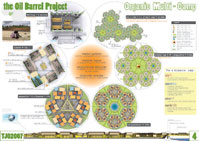
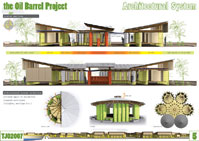
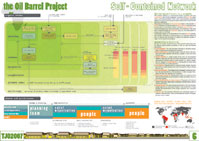
The 6 boards of the proposal: [click to enlarge]
The problem context
Large scale disasters do not arise from natural causes only; in addition to earthquakes, floods, or draughts, it is human activities that occasionally force large populations to flee their homes and relocate elsewhere -temporarily or permanently.
Man-made environmental disasters do not always happen suddenly like in Bhopal or Chernobyl. Usually they develop little by little until they eventually exceed a 'tolerance threshold'. People have to abandon their land then, and settle in a more hospitable environment for a while, until the cause of their flee is gone.
An example of such man-made disaster is lurking for years in the region of Niger Delta in south Nigeria, where lessez-faire practices by oil companies have caused a pollution of enormous scale. Several reports on that particular crisis have drawn our attention. Here are some excerpts describing briefly the current situation:
"The Niger Delta, the delta of the Niger River in Nigeria, extends over about 70,000 km² and makes up 7.5% of Nigeria's land mass. Some 20 million people of more than 40 ethnic groups, speaking some 250 dialects live in the Delta, primarily occupied with fishing and farming.
Two million oil barrels a day are extracted in the Niger Delta. Much of the natural gas extracted in oil wells in the Delta is immediately burned, or flared, into the air at a rate of approximately 70 million m³ per day. This is the single largest source of greenhouse gas emissions on the planet. The environmental devastation associated with the industry and the lack of distribution of oil wealth have been the source and/or key aggravating factors of numerous environmental movements and inter-ethnic conflicts in the region, including recent guerrilla activity by the Movement for the Emancipation of the Niger Delta (MEND).
From the point of view of MEND and its supporters, the people of the Niger Delta have suffered an unprecedented degradation of their environment due to unchecked pollution produced by the oil industry. As a result of this policy of dispossessing people from their lands in favour of foreign oil interests, within a single generation, many now have no ability to fish or farm. People living in the Niger Delta have found themselves in a situation where their government and international oil companies own all the oil under their feet, the revenues of which are rarely seen by the people who are suffering from the consequences of it.
Oil spillage has a major impact on the ecosystem into which it is released. Immense tracts of the mangrove forests, which are especially susceptible to oil (this is mainly because it is stored in the soil and re-released annually with inundation), have been destroyed. An estimated 5-10% of Nigerian mangrove ecosystems have been wiped out either by settlement or oil. The rainforest which previously occupied some 7,400 km² of land has disappeared as well.
Spills in populated areas often spread out over a wide area, taking out crops and aquacultures through contamination of the groundwater and soils. Though the consumption of dissolved oxygen by bacteria feeding on the spilled hydrocarbons also contributes to the death of [river] fishes. In agricultural communities, often a year's supply of food can be destroyed by only a minor leak, debilitating the farmers and their families who depend on the land for their livelihood. Drinking water is also frequently contaminated, and a sheen of oil is visible in many localized bodies of water. If the drinking water is contaminated, even if no immediate health effects are apparent, the numerous hydrocarbons and chemicals present in oil are highly carcinogenic. Although, people often do manifest sickness following consumption of polluted water.
The decline in ecologic sustainability parallels the increase in oil production since operations began four decades ago. Furthermore, operating companies such as Shell have made public proposals for increasing production significantly in the near future which, because of the careless nature of oil operations in the Delta, will cause the environment to grow increasingly uninhabitable." [Wikipedia 2007]
"It is pertinent to note that oil spillage, gas flaring and all other forms of environmental disaster constitute serious environmental hazards particularly to flora and fauna. Farmlands and sources of potable water are often polluted by on-shore spills. Inhabitants of oil producing areas often lose their means of livelihood to the disaster. To these victims, the phenomenon is most devastating.
Oil spillage is a worse form of pollution which poses great threat to man, the ecosystem and the environment. It is even worse because the impact of environmental pollution is usually felt on long-term, recurrent basis, making it difficult to arrive at an exact impact assessment as the incident occurs. Unfortunately this has been the lot of the oil producing communities.
Incidents of oil spillage had in the past caused irreparable damage on the farmlands and streams in the oil producing communities, often reducing inhabitants of the affected villages and communities to refugees. In some cases, the spillage has directly or indirectly caused death of people.
The magnitude of oil exploration activities in Niger-Delta is so enormous that the toxic effect of oil pollution and spillage on biological species, water contamination and habitat disturbance pose great biochemical and ecological impact." [Ekpenyong E., 2006, 'Environmental crises in Niger Delta', Sun News]
"Over the past decades, the Niger Delta terrain has been overrun through deliberate over-exploitation carried out in total disregard of the basic principles of sustainable environmental management. On the extent of damage caused by the oil firms, from available information, close to 4,000 oil wells have so far been drilled in the Niger Delta and offshore areas since 1957. The 4,000 sites constitute potentially polluted sites at which drilling wastes, drill cuttings, oil sludge's and various toxic hazardous chemicals have been disposed.
The region is exposed to a large proportion of the environmental degradation and health hazards, which normally accompany exploration and exploitation of crude oil. The frequency of oil spill in the region is no longer news as its negative impact on the aquatic and terrestrial ecosystem is well known.
Decades of dictatorship, a breakdown of civil society, and a near complete lack of attention to environmental concerns have turned the Niger delta into one of the world's most endangered ecosystems; an epicenter of human rights abuses and environmental injustice. However, since electing a civilian President in 1999 -- its first in nearly two decades -- Nigerians in the Niger Delta have embarked on a new campaign to seek environmental justice. Also, tackle the Herculean environmental disaster left in the wake of oil exploitation and the dislocated economic needs of the people of the region." [Ofehe S., 2005, 'Seeking Environmental Justice for the People of Niger Delta']
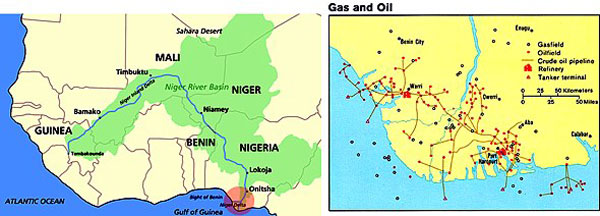
Figure 1: Map of Niger River Basin in West Africa, and oil installations in the area
Our scenario
The above lines show that the Niger Delta situation clearly illustrates the socio-economical dimension of the environmental crisis, where local inhabitants are 'collateral damages' in the clash between human greed versus nature. Up to now the extent of the disaster is apparently limited; however if the situation is left unattended (as the most likely forecast is, given the forces pulling global strings in our era) then a large scale environmental catastrophe is just waiting to happen.
In that case, an unforeseen number of people, from a few hundred to several thousand, should be transferred out of the contaminated area, perhaps for a long time. But even if the cleaning process begins voluntarily before a major disaster, relocation could be necessary in some cases until the decontamination process is completed.
Assumptions
Our goal is to provide not just a temporary shelter, but also a basic framework for living as close to normal as possible. In that, we make the following assumptions:
-Local participation: The locals will widely participate in the whole process, both in constructing and operating the compound.
-Shelter and infrastructure: Dwellings should be combined with the vital infrastructure for water, sanitation and electricity, available in short time and at minimum cost.
-'Physical networks' (i.e. cables & pipes of any kind) are not considered feasible in large scale, and they are limited to focal points only where they are treated as communal assets. In some functions -e.g. water or sewage- they are replaced by 'human networks', i.e. the allocation of certain duties and responsibilities among the population.
-Local resources: Materials should be cheap and locally available, requiring the minimum possible building skills and minimizing the need of shipping from far away.
-Maximum self-support: The refugees should be engaged in productive activities -like small scale farming, handcrafts, and manufacture- in order to support themselves with their own means as much as possible.
-Ordinary everyday life: Besides physical needs, the compound should offer provisions for basic social and spiritual matters, like religion, leisure, or communal activities.
-Decentralized & flexible, yet coherent structure: The physical and functional scheme should allow various levels of autonomy and self-reliance within a collective association.
-Unknown life-span: The whole scheme should allow for short and long staying, perhaps even for a permanent relocation if need be; therefore it should facilitate the transformation of the refugee compound into a long-term settlement.
-Unknown size: The population affected by the hypothetical disaster is unknown, hence the layout should accommodate any number of refugees, perhaps coming in stages.
A particularly important objective is to avoid a proposal that necessitates a substantial expenditure for a large stock of prefabricated units etc., which will be stored somewhere waiting for the next disaster, probably far from the crisis location. The unwelcome capital commitment in the form of dormant stock could perhaps be overcome if fabrication begins after the crisis, but that would delay the relief of victims. Either before or after the crisis, shipping a large volume of significant weight to a faraway location leads to additional financial and environmental burden.
Actors & phases
The implementation of the proposal requires four main actors:
1. The designers, for advice during planning and construction
2. A relief organization, for coordination, training and monitoring
3. A local authority, for management and support
4. The affected people themselves, as the key decision makers and main workforce.
These actors cooperate during implementation, where the main phases are:
a. Site selection & preparation
b. Application of site layout according to topography and size
c. Materials shipping
d. Building a model Cluster as a training example for locals
e. Actual construction of individual dwellings and the communal facilities
f. Fine-tuning, supervising, and monitoring the operation of the scheme.
The layout
A major feature of the proposal is the daisy-like pattern that is applied at several scales:
-The basic module is the Cluster, accommodating ~30 members of an 'extended family' according to the local habits. The Cluster consists of 5 separate dwellings plus a washroom ('Wet Space') around a common yard with cooking facilities.
-Six Clusters form a Marguerite for ~160 people, with space for their poultry and livestock in the middle.
-Six Marguerites create a Neighbourhood for nearly 1,000 people (30-40 extended families) sharing a water reservoir and electricity outlets.
-Six Neighbourhoods comprise a Primary Camp of up to 6,000 people around common facilities for administration, health, food store, etc. this is a self-contained entity in terms of water, electricity, and other essentials, occupying 55 hectares -i.e. ~90 m2 gross area per person including farming land.
-Any number of refugees above 6,000 can be accommodated in multiple Primary Camps or a Multi-Camp, arranged according to topography. In that case each Primary Camp has a particular feature that might be too big to repeat in all of them, such as a hospital, special education facilities, high-level administration, or commercial venues. Such a plan facilitates the transformation of the refugee settlement into a normally functioning town in the case of long-lasting relocation.
The vacant land is used for food production at various scales, from small vegetable gardens up to communal farms. This, together with animal raising for food and handicrafts, are important activities for self-support, reducing at the same time the potential dangers of an idle poor population.
Aiming at a sensible de-centralization, a similar escalating structure is envisioned for decision-making and allocation of responsibilities in the camp.
Climatic context
Port Harcourt is the major urban centre in the Niger Delta region. Local meteorological data indicate a warm and humid area, characterized by narrow diurnal and seasonal temperature fluctuations, plus high rainfall, cloudiness, and relative humidity (Figure 2). Solar irradiation varies little between seasons, although sunshine duration is lower during the rainy late summer. The low clearness index and relative sunshine duration (Figure 3) denote a high percentage of diffuse solar radiation during most of the year, implying reduced need for protection from direct solar rays. Enhanced ventilation, minimal thermal mass, and protection from heavy rains are the long-established building features in such climates.

Figure 2: Basic climatic data for Port Harcourt (Horizontal Radiation, Precipitation, Sunshine Duration) [source]

Figure 3: Solar data in Onne, next to Port Harcourt (Horizontal Radiation, Clearness Index H/HO with Relative Sunshine Duration S/SO) [source]
The oil barrelA key component of the proposal is the extensive use of oil barrels as a building material. Perhaps it is an irony to use oil industry items to confront problems created by it; nevertheless, oil barrels are easily available in huge quantities in the area, lessening the load of materials shipped from far away. Their initial content is replaced by soil, to form load bearing columns with the addition of timber posts as a stabilizing axis.
The oil barrel columns support a timber frame roof from local wood, covered with corrugated metal sheets or flattened barrels. The same generic type of construction can be used for a wide range of applications, including communal structures.
The Four Elements
The proposal addresses the environmental aspects through the ancient Four Elements idea (Fire, Water, Air, and Matter) not as a philosophical concept but as a practical way to classify natural factors. This has been applied in the individual dwelling as well as in the entire camp scale.
Fire (heat & light)
Heating is no issue in the Niger Delta. Practical measures for natural cooling in dwellings include low thermal mass and ample ventilation through the perforated structure. Indoor and semi-outdoor spaces are shaded by the metal roof, with a movable ceiling below that blocks infrared emission from the warm metal. Warm air under the roof is removed by the wind (ventilated roof). The metal roof is cooled down during the night due to sky radiation; the ceiling (in fact, a drape) is drawn during the night to allow the cool air under the metal to flow down. [The cooling potential through radiation to the night sky varies from 7 W/m² for heavily overcast sky to 75 W/m² for clear dry atmosphere (Parker D.). Whatever the actual quantity, it is free energy that can be utilized at no extra cost.]
Electricity is not provided to the dwellings, to avoid the need of expensive technology (PV panels or wind turbines with inverter & batteries in each unit, or electric distribution from a central power source). However, an amount of electricity is produced by solar or wind energy in each neighbourhood, used primarily for potable water pumping and purification. An amount of that power is allocated for VHF radios and rechargeable batteries for personal use by the refugees.
Artificial lighting in the dwellings is provided by conventional oil lamps; however, one should consider the option of distributing solar lamps to households with children attending school as a tool and an incentive for education.
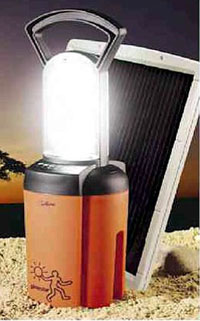
Figure 4: A solar lamp with its PV panel behind
To reduce the wide-spread problem of tree clearing for firewood, the proposal is to use propane bottles for cooking, supplied through the supervisors of the camp. That gas could come from the oil installations of the region, if the dangerous insanity of gas flaring would be replaced by gas tapping, for the benefit of the local population and the global atmosphere. It is worth noting that "Gas flaring wastes millions of cubic feet of gas every day, costing Nigerians at least $2.5 billion per year, according to the Nigerian group Environmental Rights Action, which says the World Bank estimates flaring in Africa could produce about 50% of the current power consumption of the entire African continent." [source]
Solar cookers could be proposed as another alternative; however their performance is questionable under overcast sky, in rainy days, and of course during the night.

Figure 5: Wood is the major energy source, whereas natural gas is wasted instead of being put in practical use.
The local solar regime is rather unfriendly for solar cooking.
Water
Rain protection is provided by the metal roof and side panels, while floors stand above the flood level. Rainwater from the roof is directed to a number of oil barrels used as water containers for household washing and sanitation. Part of the collected water is transferred via buckets to the washroom or 'Wet Space' of each Cluster that houses toilets, showers, and laundry facilities (Figure 7).
Potable water is an issue of paramount importance; the proposal includes a circular reservoir at the centre of each Neighbourhood, where rainwater is collected and stored. The water is purified and distributed through taps, one per Marguerite. A highly interesting alternative would be to employ the Air-to-Water concept, i.e. converting air moisture into potable water through condensers operating with solar or wind electricity. That is the most practical option during construction, employing movable units like the one shown in Figure 6.
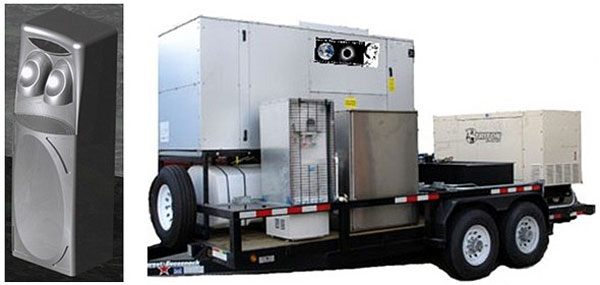
Figure 6: Small and large examples of Air-To-Water units
Sewage is another major issue. A septic tank per Cluster would create technical problems, mainly due to frequent floods that require costly construction measures. Thus, the design provides one 'Wet Space' per Cluster, with toilets over a wheeled barrel that periodically is loaded on trucks and discarded at a remote waste treatment location serving the entire camp.
The latter could become a nuisance pretty soon; therefore, in the 2nd phase of the project ('Camp Enhancement'), an urgent priority should be a kind of biological treatment of waste.
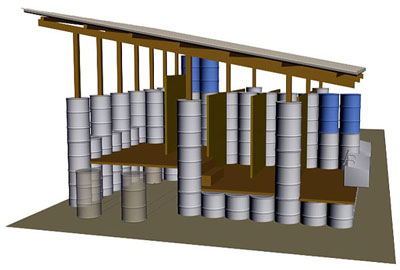
Figure 7: A Wet-Space; it is similar construction to dwellings, with the deck elevated under the toilets.
Air
Ventilation is the typical response to high temperature and humidity. The large gaps between the barrel columns leave enough room for that, similarly to the gaps between the floor planks, and the volume under the metal roof (ventilated roof). The thermal function of the roof (overheated in the day, cooled in the night) could generate a kind of solar-chimney effect during windless periods.
As privacy is reduced by the large gaps, perforated panels made of cane or similar materials could be a handy solution in order to compromise neither ventilation nor privacy.
Earth & material things
Soil is extensively used as infill in the barrel columns. It is also used to construct the water reservoirs, waterproofed by HDPE lining.
Recycling and waste processing is a fundamental concern in any sustainable scheme. The use of oil barrels is a case of extensive recycling, reducing the necessary amount of other building materials and the energy needed for long-distance shipping to the site. Furthermore, metal barrels as a building material are easily collected and reused or recycled at a later stage.
Organic waste from the Clusters and the manure of the various animals is used as fertilizer in the farming areas. The application of composting process for methane production is meaningless, given the enormous amounts of natural gas available in the area that currently are just wasted boosting the greenhouse effect only.
Another major issue of sustainability is local availability. In this case, besides the abundant oil barrels, local timber is easily obtainable and therefore it is extensively used in all constructions.
The critical situation requires cooperative solutions under central control in basic matters. Therefore an important feature at Primary Camp level is the Hardware Warehouse where the necessary building materials and hardware are stored during the construction stage, as well as for later repairs and further improvements. Similarly, the Food Warehouse is used to store foodstuff coming either from external aid or from the local farms.
Design Scope
The Niger Delta is not the only area facing environmental threats by human actions or natural phenomena. The use of oil barrels as a key building ingredient and the environmental attributes of the design, address conditions in oil-producing regions with a warm and humid climate. Therefore the scheme could be applied in any of the red regions shown in Figure 8.
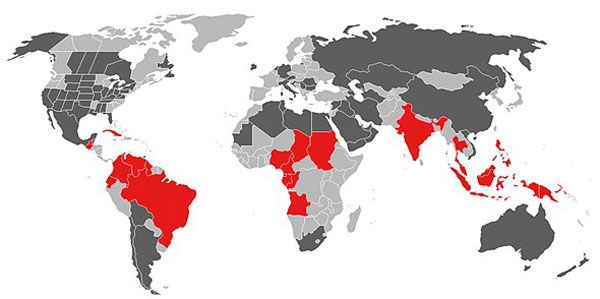
Figure 8: Areas where the Oil Barrel Project could be applied
Thanos N. Stasinopoulos
Dr. Architect Eng. NTUA, AAGradDipl.
8.4.2011
Related articles:
- Pills or diet? ( 31 August, 2011 )
- The fever of the naked emperor ( 15 November, 2010 )
- After the bubble gums ( 12 September, 2010 )
- Thanos Stasinopoulos .PIRAEUS TOWER 2010 ( 08 October, 2010 )
- Barriers, barriers everywhere ( 14 December, 2010 )
- Scenarios for the future ( 10 January, 2011 )
- Parks and submarines ( 21 February, 2011 )
- “We are animals” ( 02 June, 2011 )
- On Winds and Waters ( 11 July, 2011 )
- The Titanic ( 07 October, 2012 )
